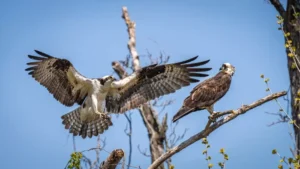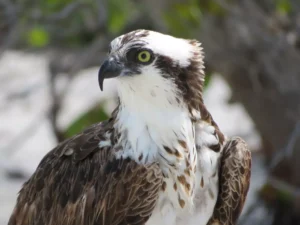Osprey is a large, powerful bird of prey with a stout body and long wings. The osprey has a white head with a dark stripe running through its eye, and a dark back. It is the only raptor with reversible outer toes, which it uses to grasp its prey.
Ospreys are found on all continents except Antarctica. They typically build their nests near water bodies such as lakes, rivers, and coasts.
Osprey birds are one of the most popular and easily recognizable birds in North America.
They are known for their distinctively shaped head, hooked beak, and large eyes. Ospreys are also called fish hawks because they primarily eat fish.
Ospreys are relatively small birds of prey, with a wingspan of about six feet. They have dark brown upper parts and white underparts, with a stripe of dark brown running down the center of their breast.
Their legs are short and strong, with sharp talons that help them to catch fish.
Ospreys typically mate for life and build their nests together near bodies of water. The female lays two or three eggs at a time, which the parents take turns incubating.
Once the chicks hatch, they are cared for by both parents until they are old enough to fledge (leave the nest).
Ospreys typically live around 20 years in the wild, although some individuals have been known to reach 30 years or more. These birds can be found throughout North America, including parts of Canada and Mexico.

What is Special About an Osprey?
Ospreys are a type of hawk that is found on every continent except for Antarctica. They are unique in that they are the only raptor that specializes in eating fish.
Ospreys have several adaptations that help them to be successful at fishing, such as sharp claws, webbed feet, and a curved bill.
One of the most interesting things about ospreys is their nesting habits. Ospreys usually mate for life and return to the same nest year after year.
These nests are large platforms made of sticks and twigs and are often built in high places like cliffs or trees.
Osprey nests can be used by other birds, such as eagles or crows, but ospreys will always reclaim their nest if given the chance.
If you’re ever lucky enough to see an osprey catching a fish, it’s truly a sight to behold. Ospreys dive into the water from great heights, using their talons to snatch fish out of the water.
They then fly back to their perch with the fish held upside down in their feet so that it doesn’t get away. So next time you’re near a body of water, keep an eye out for these amazing birds!
Is the Osprey a Hawk Or an Eagle?
The Osprey is a raptor or bird of prey. It is sometimes called a hawk and sometimes called an eagle. The Osprey is actually in its own separate family of birds, called Pandionidae.
The osprey is a large bird, with a wingspan of up to six feet. It has dark brown upper parts and white underparts. The head and neck are white, with a dark brown stripe running down the center of the head.
The bill is black, and the eyes are yellow. The osprey eats fish almost exclusively. It hunts by swooping down over the water and grabbing fish with its talons.
Ospreys can be found near bodies of water all over the world. So, what exactly is an osprey? Is it a hawk or an eagle?
Technically, it’s neither. But it is definitely a raptor!

Is an Osprey a Kind of Eagle?
No, an osprey is not a kind of eagle. The Osprey is a medium-sized raptor that specializes in eating fish. It is the only member of its family, Pandionidae, and is sometimes referred to as the fishhawk, sea hawk, or fish eagle.
The osprey has several distinct features which set it apart from other raptors; for example, its reversible outer toe (which allows it to grasp prey with two toes in front and two behind), spiculated feathers on the underside of its wings, and nostrils that close when diving underwater.
The adult osprey has dark brown upper parts and white underparts, with some dark streaks on the breast. Its head is white with a dark stripe through each eye, and it has a black patch on each side of its face.
Juvenile ospreys are generally paler than adults, with more streaking on their underparts. While eagles are larger birds of prey that can take down large animals such as deer or small mammals like rabbits, the osprey only hunts for fish.
It dives into the water after spotting its prey from above, then uses its sharp talons to kill and carry the fish back to its nest (often a large platform made of sticks).
Ospreys typically mate for life and will return to the same nesting site year after year. So while an osprey may look like an eagle at first glance, these two birds are actually quite different!
Why is It Called an Osprey?
There are a few different theories as to why the osprey is called what it is. One theory suggests that the name comes from the Latin word for a bird of prey, “ospes,” which could have been corrupted over time to become “osprey.”
Another theory posits that the name actually comes from an Old English word, “osprey,” meaning simply “bird.”
It’s also possible that the name is derived from a Gaelic word, “uisge-breath,” meaning “water-fowl.” The truth is, we may never know for sure why this majestic bird is called an osprey.
But whatever the reason, it’s certainly a fitting name for one of nature’s most skilled hunters.
Osprey facts: they have long legs for a reason | Animal Fact Files
Osprey Bird Habitat
Ospreys are one of the most easily recognizable birds of prey, with their white and dark brown plumage and distinctive hooked beak.
These fish-eating predators can be found near bodies of water all over the world, from North and South America to Europe, Africa, Asia, and Australia.
While ospreys will use a variety of different habitats depending on where they live, they typically prefer to nest near freshwater lakes, rivers, or marshes.
In North America, you’re most likely to see ospreys nesting on platforms built specifically for them or on top of tall trees. Ospreys will also sometimes build their nests on man-made structures like power lines or buildings.
The worldwide population of ospreys is estimated to be between 70,000 and 100,000 pairs.
While this may seem like a lot, the bird is actually classified as “near threatened” by the International Union for Conservation of Nature (IUCN).
The primary threat to osprey populations is habitat loss and degradation due to human activity. Pesticides can also pose a threat to these birds, since they often eat fish that have been contaminated with chemicals.
Climate change is another potential threat to ospreys, since it could cause changes in the availability of food sources or suitable nesting sites.
Fortunately, there are many things that people can do to help protect osprey populations. For example, conserving and restoring wetlands can provide important habitats for these birds.
Reducing pesticide use can also help by ensuring that there are more safe food sources available for ospreys (and other wildlife).
Conclusion
The osprey is a large raptor with dark brown plumage and a white breast. It has long, curved talons and a hooked beak that it uses to tear apart its prey. The osprey is found on every continent except Antarctica.
It typically nests near bodies of water, where it can find fish to eat.